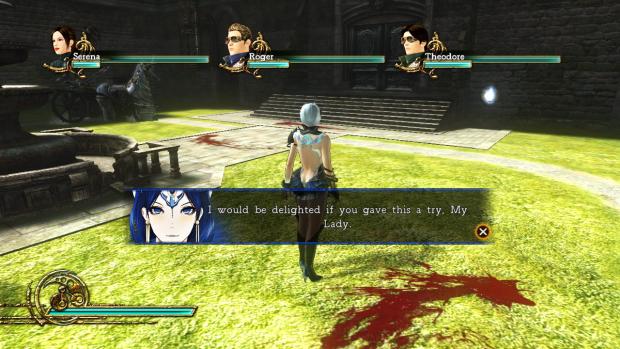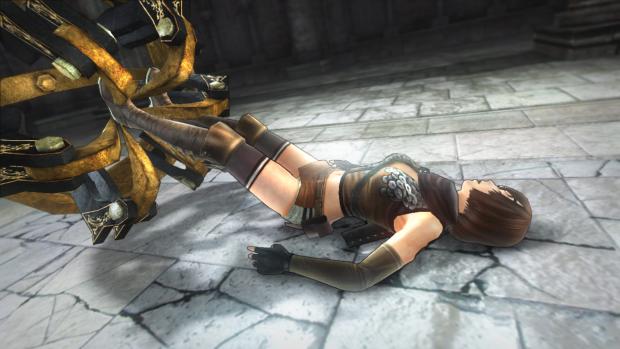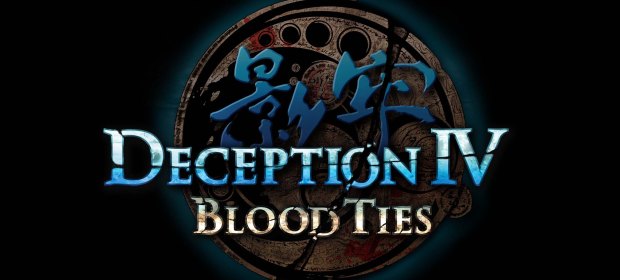It’s not uncommon these days for a game to cast its players in the role of an anti-hero, or even a villain, but few franchises do it with quite the same sadistic aplomb as Tecmo’s Deception series. Beginning life on the PSOne all the way back in 1996, the franchise reaches its fifth iteration, confusingly, with Deception IV: Blood Ties.
The plot, as thin and drawn-out as it is, focuses on four witches, living fragments of the soul of an ancient, evil creature referred to as The Devil. The main player character, Laegrinna, is the eldest and most respected of the four, and is aided by her sisters throughout. Initially holed up in a gothic castle, the sisters are constantly assailed by the armies of the nearby city who want to eradicate their evil, an arrangement that suits the sisters just fine as they themselves are trying to collect the Holy Verses, a powerful artefact that can help return The Devil to Earth.
The various inept, sadistic or downright insane enemy captains who assault your castle are universally begging for a kicking, which is delivered medieval style with the huge selection of traps at Laegrinna’s command. Each area (evil castle, abandoned factory, etc) is a collection of rooms and adjoining corridors in which you can place a number of deadly or humiliating traps to repel your invaders. The goal of each stage is to create trap combos and use the environment to kill your enemies in the most creative ways possible, earning points spread across three disciplines: Sadistic, Elaborate and Humiliating.

For example, if you find yourself in a room with one enemy, you may wish to lay a springboard trap, which will catapult him into a bear trap, which will then hold him until you unleash a huge swinging axe blade that will knock him, almost dead, against a wall in which you’ve concealed a huge grid of sharpened wooden stakes. Each trap is laid with an initial cooldown timer, and you must kite the enemy into them in the right order and activate them manually. There are also environmental Stage Traps to be triggered, such as giant cannons, falling statues and steam trains. Traps are laid using a top-down grid-based view of the room, accessed by pressing Circle, and each one can only be used once. You can also earn extra rewards by completing requests given by Laegrinna’s sisters, such as killing an enemy with a certain trap.
Strategy comes into play for two main reasons. The first is that for all her twisted sadism, Laegrinna is fairly delicate. You can’t fight back against your attackers, and can only evade, dash and heal to steer clear of trouble and, as she can be injured or killed by the Stage Traps, you need to be aware of your surroundings at all times. Then there the multiple enemy types. Activating the Devil’s Eye technique when an enemy enters a room allows you to inspect them, working out their strengths and weaknesses. Heavily armoured troops are resistant to bear traps and arrows, for example, while acrobatic rogue-like soldiers are weaker but will dodge most mechanisms. Then there are enemies with guns, flame-throwers and heavy weapons that stun you; there are enemies who can hurl fireballs at you, and there are bosses, who usually show up during the third act of a stage along with a few other nasties and who can heal themselves several times.

You earn Ark for every successful trap, which is pointlessly converted into “Warl” after a stage so you can buy new traps, abilities, and costumes. Progression through the story increases the number of traps you can take into a Stage, allowing you a more diverse mix. The trick is to link high-damage combos, knocking your enemy around the screen amid gouts of blood and broken armour. It’s perversely satisfying to reduce a heavily armoured trooper to his underwear and smack him in the face with a comedy mallet before making him stand on a rake and totter backwards into a ten-foot buzzsaw. The number of traps is impressive, and they combine incredibly well with the Stage Traps to let you really be creative with your kills.
That being said, there are times when Deception IV is frustratingly difficult. Take the wrong combination of traps and abilities into a stage and it can be incredibly hard work just to clear out the grunts, and it’s often annoying just how many tricks the enemy has to use against you. Getting shot is often fatal, as enemies can and will shoot you on the ground to stop you escaping, and if you get staggered by a mace-wielding soldier just as a sorcerer lobs a fireball, you will rage good and loud. Learning the timing of each trap is essential, as is knowing exactly where on the floor a trapped enemy will be deposited. You can also be passive, if you like, and simply capture weakened enemies in huge iron cages – but it’s hardly as much fun as dropping a giant pumpkin on their heads and making them walk into the path of a gargantuan boulder.

Deception IV is decent enough to look at, but reused character models and bland environments do it no favours aesthetically. Semi-static cutscenes (all voiced in Japanese and thus neatly side-stepping any awful voice-acting and dodgy localisation) tell the story between stages, but quite honestly it’s almost impossible to truly engage with the story in any meaningful way – you simply do what’s asked of you as you progress towards one of several different endings.
VERDICT: With an option to replay any mission once a chapter is done, or indulge in a Free Play mode to practice your trapping skills, there’s plenty of content on offer here. The repetitious structure and puddle-deep story are offset nicely by the huge variety of traps and the scope to combine them all in such grizzly ways. More creative or, dare I say, gorier death animations would have been welcome, but on the whole Deception IV: Blood Ties is something different. Fans of the franchise will know what to expect, but newcomers might find themselves pleasantly surprised by the mix of strategy, sadism and dark humour.

GOOD. A game that scores 7/10 is worthy of note, but unworthy of fanfare. It does many things well, but only a few of them incredibly well and, despite a handful of good qualities, fresh ideas and solid mechanics, it fails to overwhelm.
Review code provided by publisher.






